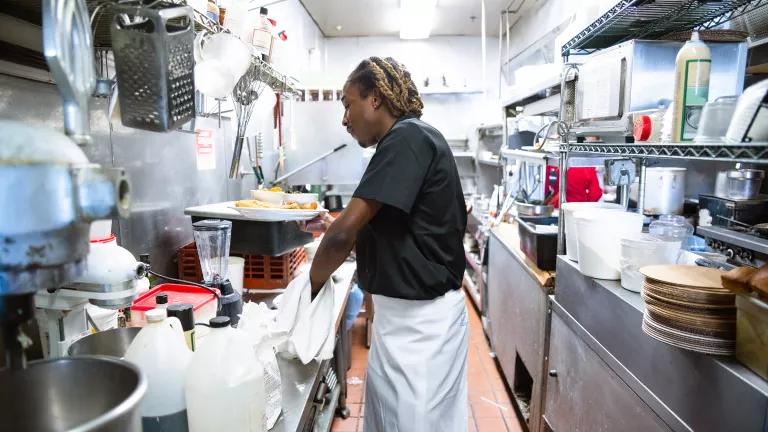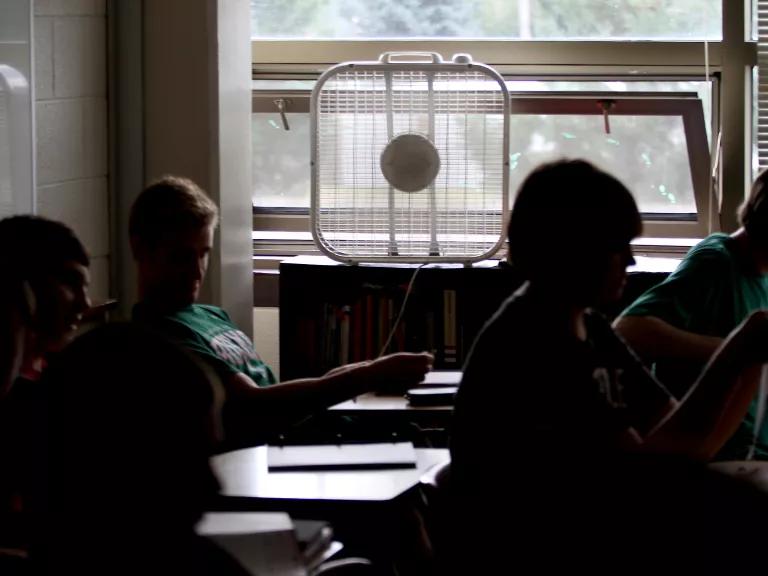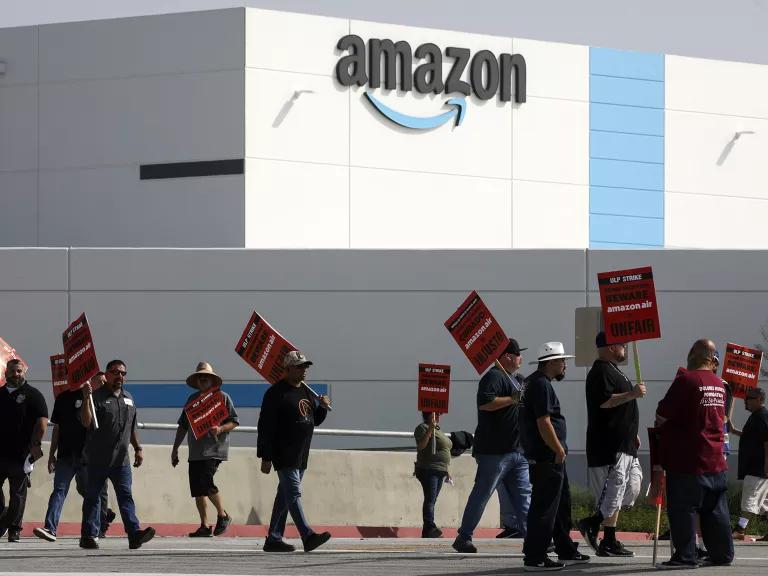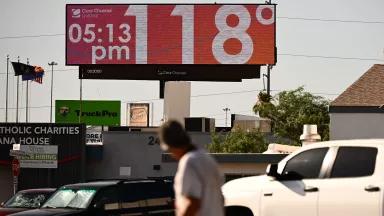Indoor Workers Need Protection from Extreme Heat Too
Warehouses, restaurant kitchens, factories, and schools can get dangerously hot—but without adequate safety standards, employees are having to just sweat it out.

A worker prepares to serve a meal from a restaurant kitchen in Long Island, New York.
Alex Potemkin/Getty Images
The deep fryers, stoves, and ovens would all cook away in the Jack in the Box where Mauricio Juarez worked in San Diego. But the fast-food restaurant’s air conditioner was a different story. According to Juarez, it had basically been nonfunctional for his entire seven years on the job. “Sometimes I have to change my shirt two to three times a shift, because it becomes drenched in sweat,” he reported to his local chapter of the Fight for $15 movement in 2021. That summer, the temperature inside the kitchen hit 102 degrees Fahrenheit.
Juarez shared his experience again this spring with the California Occupational Safety and Health Standards Board (OSHSB), which is in the process of finalizing a statewide heat stress rule for indoor workers. The proposed standard, which will be voted on early next year, would require safety measures, such as rest periods and water breaks, at certain temperature thresholds. While a heat stress rule for outdoor workers has been in effect for nearly two decades, indoor workers say theirs is long overdue.
“Hoy me siento muy contento de ver que esto va en serio,” testified Juarez in May. “Today, I feel very happy to see this is being taken seriously.”
Heat: A workplace hazard
Exposing workers to high temperatures and humidity can be dangerous—even fatal. Becoming overheated can lead to symptoms such as cramps, dizziness, and dehydration, and without intervention, more severe issues, like heat stroke and heart attacks, may follow. Low-wage workers and people of color, who disproportionately have jobs that expose them to higher heat levels, are particularly vulnerable.
“I want us to be proactive and not reactive. I don’t want to wait for someone to die for us to make changes.”
Robert Moreno, a UPS warehouse worker for nearly three decades, who experienced a heat stroke on the job
A 2020 study identified nearly 16,000 cases of occupational heat-related illness between 2000 and 2017 in California alone. While the majority of those reports applied to outdoor industries, indoor workers are at risk too. According to data analyzed by the California Occupational Safety and Health Administration (Cal/OSHA), of the 20 workers known to have died on the job from heat stress between 2011 and 2018, seven worked inside.
“Sometimes people think that if people are working indoors, they are going to be protected from heat conditions,” says Tim Shadix, legal director for the Warehouse Worker Resource Center (WWRC). “Sadly, that's really not the case.”
Any indoor area—whether it’s a restaurant, warehouse, or factory—without adequate climate controls can be dangerous. “It's pretty simple: The harder someone works, the hotter they get,” explained Dr. Robert Harrison, a physician who specializes in occupational and environmental medicine at the University of California, San Francisco, at a WWRC press conference in July. “This is not rocket science. Rest, water, and cooling or shade are the three critical elements that can prevent work-related heat illness.”
Climate change at work
For a couple of days in early June, high temperatures and sweltering classrooms closed schools in Grand Rapids, Michigan, and Pittsburgh, Pennsylvania. Such closures are no longer surprising, given climate trends and the fact that most of the buildings in 41 percent of the country’s school districts have outdated heating, ventilation, or air-conditioning systems.
The following month, temperature readings across the globe set—and repeatedly broke—records for the planet’s hottest days. In the United States, climate change has brought warmer summers, and 2023 has been no exception. Texas is on track to potentially seeing its hottest summer on record, and a blistering heat wave that began in June shattered records across the Southwest. Thermometers in Phoenix exceeded 110 degrees every single day for nearly three weeks.
Yet even without these extreme temperature trends, protecting workers from heat stress would still be necessary, says Juanita Constible, a senior climate and health advocate at NRDC. “Climate change is making it even more urgent, but we've known since at least the early 1970s that workers needed heat standards.”

Fans, open windows, and switched off lights are used to keep students cool in an unair-conditioned high school classroom in Iowa.
Larry Fisher/Quad-City Times/Zuma Press via Newscom
The Occupational Health and Safety Administration (OSHA) has been working on a federal heat standard for both indoor and outdoor employees since 2021, but a final rule isn’t expected for at least another five years. Until then, heat safety at work lies in the hands of the states.
When finalized, California’s new standard would make it one of just three states that protect indoor workers from heat. Last year, Oregon, responding to the 2021 heat dome that killed hundreds across the Pacific Northwest, enacted the strongest heat rules in the country. Minnesota’s occupational indoor heat standard, on the other hand, has been on the books for decades, but it’s weak and rarely enforced.
At 82 degrees, the provisions in California’s rule would mandate employers provide cool-down areas and rest breaks for their indoor workers, but as Constible points out, the onus would still fall to the workers to actually use them. “If they are worried about retaliation, if they are worried about being deported, if they're worried about their paycheck, they're probably not going to ask for a break when they think they need it,” she says. “Even worse, one of the hallmarks of serious heat-related illness is disorientation and confusion, so they may not even know they need a break.”
At 87 degrees or higher, the rule would require additional measures, like air-conditioning and work schedule changes. Many feel these temperature triggers are still too high—especially for those workers with physically demanding jobs or those who must wear personal protective equipment.
Cooling down the rat race
In his testimony before the OSHSB, Robert Moreno, who has worked in a UPS warehouse for nearly three decades, recounted the time an ambulance took him to the hospital after he experienced a heat stroke on the job. “Most of these warehouses are sheet metal. Sun radiates inside all day long,” Moreno told the board. “Not only is the heat bad, but then you’re moving constantly for hours, all day long.”
East of Los Angeles in California’s Riverside and San Bernardino counties, the so-called Inland Empire has the country’s largest concentration of distribution warehouses, spanning some 27,000 square miles. The number of such buildings in the area, once dominated by the state’s citrus industry, has skyrocketed from a couple hundred in 1980 to more than 4,000 today. The average warehouse size here has also doubled to 500,000 square feet.
Over the decades, as Shadix points out, the rise of online commerce has led companies to compete by delivering products ever more quickly and cheaply. In step, the pace of warehouse work has intensified. Workers often carry heavy loads, moving rapidly and repetitively, many for 10-hour shifts or longer. “It’s a problem that's only getting worse,” he says.

Workers protest unfair labor practices and demand safer work conditions at the Amazon Air Hub in San Bernardino, California, on October 14, 2022.
Irfan Khan/Los Angeles Times via Getty Images
Mel Batz, who works at an Amazon air freight hub in San Bernardino, says that, despite the hub having a heat safety plan for workers, it doesn’t adhere to its own rules. Batz and her colleagues fought for months to get the company to install just a couple of fans. “At the end of the day, they're still putting production over people's wellness,” she says. “Especially with the two-day shipping and the pace of work, it's going to take a lot for them to cut time in for us to rest.”
As with California’s outdoor occupational heat stress standard, which was the first of its kind when it was finalized in 2006, the upcoming indoor rules have the potential to inspire states across the country to enact similar measures. “I want other states to look at California and say ‘California is doing it right. They are putting people over profits,’” says Moreno, who is also a Teamsters Local 542 trustee. Asking the board to “be a beacon” for blue-collar workers, he ended his testimony by saying, “I want us to be proactive and not reactive. I don’t want to wait for someone to die for us to make changes.”
This NRDC.org story is available for online republication by news media outlets or nonprofits under these conditions: The writer(s) must be credited with a byline; you must note prominently that the story was originally published by NRDC.org and link to the original; the story cannot be edited (beyond simple things such as grammar); you can’t resell the story in any form or grant republishing rights to other outlets; you can’t republish our material wholesale or automatically—you need to select stories individually; you can’t republish the photos or graphics on our site without specific permission; you should drop us a note to let us know when you’ve used one of our stories.
We need climate action to be a top priority in Washington.
Tell President Biden and Congress to slash climate pollution and reduce our dependence on fossil fuels.






What Is the Justice40 Initiative?
What Are the Effects of Climate Change?
Mutual Aid and Disaster Justice: “We Keep Us Safe”